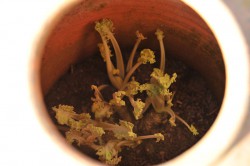Special Offers
Redeem Offer Code
Redeem Gift Voucher
Scarecrow Members
Our Feedback
Thank you so much for a very prompt service. I am impressed! I cant wait to see my flowers in bloom. I would certainly recommend you and will use your site in the future. Thank you.
Christine Stewart, Peterborough
Sea Kale Plant Lily White






Crambe maritima 'Lily White'
- Once a most popular vegetable, this long predates Victorian times and was often found near the seaside.
- Can be forced.
- Salt air and drought tolerant.
- Easy to grow.
Supplied as compost block grown plants.
Available from APPROXIMATELY early June1 or more £2.25GBP each. Group & quantity discounts
Currently Not Available to Buy
Description
Sea Kale long predates Victorian times and was once very popular, however doesn't seem to be so widely available now. It is sometimes grown as an ornamental vegetable but is edible.
The blanched shoots, young flower heads and very young leaves can be eaten raw or the leaf midribs cooked and eaten like Asparagus; forced Sea Kale is also a real delicacy.
It is best if picked and eaten, rather than stored.
As the name implies, these are often found growing near the sea on beaches, cliffs and rocks and are tolerant of both salt air and drought.
If you have an exposed area of the garden where little else will grow consider Sea Kale as it will happily colonise it and turn non-productive ground into productive ground.
- Halophyte perennial.
- Set out 2 feet (60 cm) apart in rows 2 feet (60 cm) apart.
- Sea Kale is a close relative to Brassicas so avoid planting in soil infected with clubroot.
- Grow as you would cabbages cleaning up any dead or damaged foliage as required.
- Do not start forcing plants until their third full growing season.
- Plants will deteriorate and need replacing after 5 - 7 years of cropping (ie approximately ten years from when first started).
Forcing Sea Kale
- Seakale can be forced and blanched where it has grown (meaning the same plants can be used for several years) or can be lifted and forced in warmer conditions (resulting in the plants being discarded after forcing); forcing in situ is therefore the most practical way.
Forcing In Situ
- Any time after the leaves have died right back, from Autumn until January clear away the old leaf debris.
- Cover the crowns with about 3" (7.5 cm) of dry leaves which will help to insulate the crown.
- Now cover the individual crowns with buckets or similar - traditional clay sea kale forcing pots are perfect but virtually impossible to find! Whatever you use they should be around 12" (30 cm) in diameter and at least 15" (37.5 cm) tall and must completely exclude the light. Ensure they are firmly held down so they do not blow away.
- Shoots are usually ready for cutting within about 3 months and ideally should be 4 - 8" (10 - 20 cm) long when cut. Use a sharp knife to cut them low down with a little piece of root attached.
- Stop cutting in May and uncover plants allowing them to re-grow.
- They can then be forced again the following season.
Forcing Indoors
- Dig up the crowns after the first frost.
- Pot up into gritty compost or pack into boxes or crates and place in a greenhouse or cool room.
- Exclude all light with buckets, up-turned pots or similar.
- Cut shoots as they appear, ideally at about 4" - 8" (10 - 20 cm) long.
- At the end of the season you will probably need to dispose of the plants.
General Information
A Little Information About Our Vegetable Plants (Video)
Information on the vegetable plants that Victoriana grows and how we make sure they are always hardened off before dispatch.
What's A Compost Block Grown Plant?
Information on the size of the compost blocks that Victoriana grow their plants in - and what you can expect to receive.

 01233 740529
01233 740529


